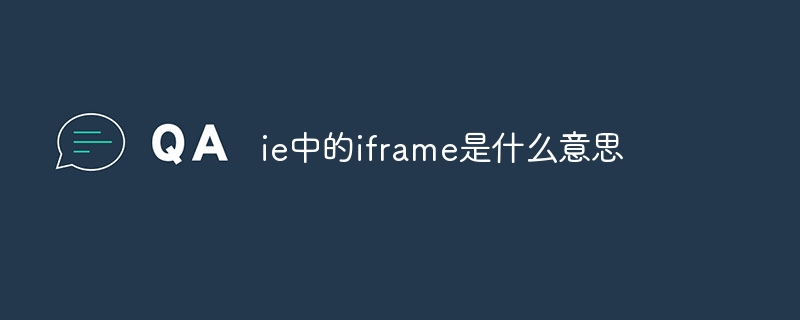iframe refers to an element in HTML, which is used to embed other web pages or documents in web pages. It can realize the nesting of web pages, cross-domain communication, asynchronous loading, security isolation and the expansion of web page functions. It can be flexibly Use iframes to improve the functionality and user experience of web pages.

# Operating system for this tutorial: Windows 10 system, Dell G3 computer.
iframe (embedded frame) is an element in HTML that is used to embed other web pages or documents in a web page. By using iframes, programmers can embed the content of other web pages into their own web pages, thereby realizing web page reuse and functional expansion.
The syntax of iframe is as follows:
<iframe src="URL" width="width" height="height"></iframe>
Among them, the src attribute specifies the URL of the web page to be embedded, and the width and height attributes specify the width and height of the iframe element. By adjusting the values of these properties, you can control the size of the embedded web page.
The functions of iframe include the following aspects:
Web page nesting: Through iframe, programmers can embed other web pages into their own web pages. This nesting can make the structure of the web page clearer and also facilitate the maintenance and management of the web page. For example, multiple iframes can be embedded in a webpage, and each iframe displays different content, thereby realizing the modularization of the webpage.
Cross-domain communication: Due to the browser's same-origin policy restrictions, a webpage can only communicate with other webpages under the same domain name. But by using iframes, programmers can achieve cross-domain communication. For example, an iframe within a web page can embed web pages from different domain names and communicate through JavaScript code.
Asynchronous loading: Asynchronous loading can be achieved by placing certain content in an iframe. For example, you can put some content that does not need to be loaded immediately in an iframe and load it when needed. This improves web page loading speed and user experience.
Security isolation: Since the content in the iframe is isolated from the parent page, the security of the web page can be improved. For example, some untrusted third-party web pages can be placed in an iframe to avoid security threats to the parent page.
Webpage extension: By embedding other webpages, webpage functions can be expanded. For example, maps, videos, audio and other content can be embedded into web pages to enrich users' browsing experience.
However, iframe also has some problems and limitations. Since the embedded web page is isolated from the parent page, it may cause some problems, such as web page style conflicts, script conflicts, etc. In addition, the loading of iframe will also affect the performance of the web page, so when using iframe, you need to pay attention to its reasonable use to avoid excessive impact on the performance of the web page.
In short, iframe is a commonly used HTML element that can realize the nesting of web pages, cross-domain communication, asynchronous loading, security isolation and the expansion of web page functions. Programmers can improve the functionality and user experience of web pages by flexibly using iframes.
The above is the detailed content of What does iframe mean?. For more information, please follow other related articles on the PHP Chinese website!
 iframe为什么加载慢Aug 24, 2023 pm 05:51 PM
iframe为什么加载慢Aug 24, 2023 pm 05:51 PMiframe加载慢的原因主要包括网络延迟、资源加载时间长、加载顺序、缓存机制以及安全策略等。详细介绍:1、网络延迟,当浏览器加载一个包含iframe的网页时,需要发送请求到服务器获取iframe中的内容,若网络延迟较高,那么获取内容的时间就会增加,从而导致iframe加载慢;2、资源加载时间长,资源的大小较大或者服务器响应时间较长时,加载速度会更加明显地变慢;3、加载顺序等等。
 微软:每次访问时 Outlook 错误都会下载“TokenFactoryIframe”文件Apr 19, 2023 am 08:25 AM
微软:每次访问时 Outlook 错误都会下载“TokenFactoryIframe”文件Apr 19, 2023 am 08:25 AM当用户通过Safari浏览器访问电子邮件服务时,微软的Outlook正在macOS上下载一个名为“TokenFactoryIframe”的神秘文件。发现Outlook在每次访问时下载的“TokenFactoryIframe”文件的用户现已广泛报告此问题。Outlook每隔几秒或至少在每次访问Apple平台上的Outlook时都会下载此神秘文件。根据我们的调查结果,这似乎是由发布到Outlook的服务器端更新错误引起的问题,与Safari或macOS无关。微软在一份
 什么技术可以代替iframeAug 24, 2023 pm 01:53 PM
什么技术可以代替iframeAug 24, 2023 pm 01:53 PM可以代替iframe的技术有Ajax、JavaScript库或框架、Web组件技术、前端路由和服务器端渲染等。详细介绍:1、Ajax是一种用于创建动态网页的技术。它可以通过在后台与服务器进行数据交换,实现页面的异步更新,而无需刷新整个页面,使用Ajax可以更加灵活地加载和显示内容,不再需要使用iframe来嵌入其他页面;2、JavaScript库或框架,如React等等。
 Python中iframe是什么意思Aug 25, 2023 pm 03:24 PM
Python中iframe是什么意思Aug 25, 2023 pm 03:24 PMPython中iframe是一种HTML标签,用于在网页中嵌入另一个网页或文档。在Python中,可以使用各种库和框架来处理和操作iframe,其中最常用的是BeautifulSoup库,可以轻松地从一个网页中提取出iframe的内容,并对其进行操作和处理。掌握如何处理和操作iframe对于Web开发和数据抓取都是非常有用的。
 iframe嵌入播放器是什么Aug 25, 2023 pm 02:13 PM
iframe嵌入播放器是什么Aug 25, 2023 pm 02:13 PMiframe嵌入播放器是一种在网页中嵌入视频播放器的技术。嵌入播放器的优点有:1、灵活性,通过使用iframe标签,可以将来自不同来源的视频媒体嵌入到同一个网页中;2、易用性,只需复制并粘贴嵌入代码,即可将播放器添加到网页中;3、可以通过设置参数来控制播放器的外观和行为;4、可以通过使用JavaScript来控制播放器的操作等等。
 ie中的iframe是什么意思Aug 24, 2023 pm 05:42 PM
ie中的iframe是什么意思Aug 24, 2023 pm 05:42 PMIE中的iframe是一种强大的工具,可以用于在网页中嵌入其他网页或文档,实现页面的分割和内容的展示。通过合理的使用和注意事项,可以充分发挥iframe的优势,提升网页的用户体验和功能性。
 什么可以替代iframeAug 24, 2023 pm 01:49 PM
什么可以替代iframeAug 24, 2023 pm 01:49 PM可以替代iframe的有Ajax请求、Web组件、框架和库、跨域通信、使用CSS布局和样式等。详细介绍:1、Ajax请求可以动态加载并显示其他网页或内容,而无需使用iframe,通过使用XMLHttpRequest对象或更现代的fetch API,可以实现异步加载内容,并将其插入到当前网页中的DOM树中,可以避免iframe的安全问题,并且可以更好地控制和操作加载的内容等等。
 iframe禁用是什么意思Aug 25, 2023 pm 02:05 PM
iframe禁用是什么意思Aug 25, 2023 pm 02:05 PMiframe禁用是指在网页中禁止使用iframe标签的功能。由于一些安全和隐私的考虑,有时候需要禁用iframe标签的使用,常见的禁用方法:1、通过设置X-Frame-Options响应头,表示不允许嵌入到任何iframe中;2、使用Content-Security-Policy,控制是否允许嵌入到iframe中;3、使用JavaScript禁用iframe标签等。

Hot AI Tools

Undresser.AI Undress
AI-powered app for creating realistic nude photos

AI Clothes Remover
Online AI tool for removing clothes from photos.

Undress AI Tool
Undress images for free

Clothoff.io
AI clothes remover

AI Hentai Generator
Generate AI Hentai for free.

Hot Article

Hot Tools

VSCode Windows 64-bit Download
A free and powerful IDE editor launched by Microsoft

SublimeText3 Mac version
God-level code editing software (SublimeText3)

EditPlus Chinese cracked version
Small size, syntax highlighting, does not support code prompt function

MantisBT
Mantis is an easy-to-deploy web-based defect tracking tool designed to aid in product defect tracking. It requires PHP, MySQL and a web server. Check out our demo and hosting services.

mPDF
mPDF is a PHP library that can generate PDF files from UTF-8 encoded HTML. The original author, Ian Back, wrote mPDF to output PDF files "on the fly" from his website and handle different languages. It is slower than original scripts like HTML2FPDF and produces larger files when using Unicode fonts, but supports CSS styles etc. and has a lot of enhancements. Supports almost all languages, including RTL (Arabic and Hebrew) and CJK (Chinese, Japanese and Korean). Supports nested block-level elements (such as P, DIV),






